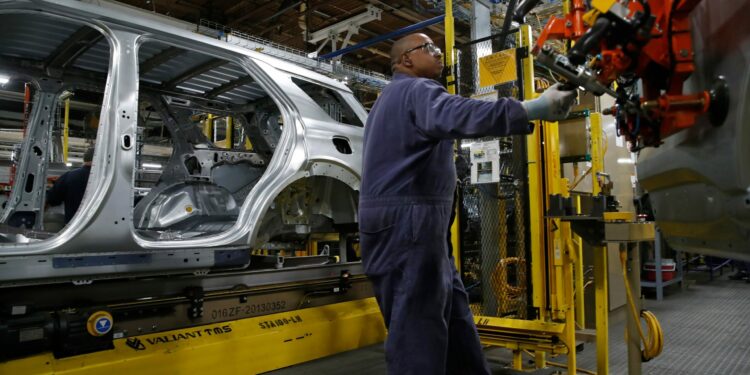Shiny new vehicles cover a Toyota dealership along Interstate 610 in Houston, Texas. The lot includes Tundras made in Texas and Tacomas made in Baja California.
“These are not American vehicles, they’re not Mexican vehicles,” said Tony Payan, executive director of the Center for the U.S. and Mexico at Rice University. “When you see a plant where a vehicle is being built, what you see is parts coming from many different places.”
Take an auto manufacturing plant in Mexico, where labor is cheap: “You see a lot of different component parts that are coming in from the United States. They get to the plant, and then they get assembled in Mexico,” he said.
One example is time and labor-intensive harness assembly, which often is handled in Mexico.
“Then some of the harnesses and other parts cross into the United States. The software gets installed in the United States. And so, it’s a very circuitous route,” he said.
Having component parts cross the U.S.-Mexico border several times during the manufacturing process is economical because of the North American Free Trade Agreement, which was signed in 1992.
It was in nearby San Antonio, where President George H. W. Bush met with Mexican President Carlos Salinas de Gortari and Canadian Prime Minister Brian Mulroney for an initialing ceremony.
“We are creating the largest, richest and most productive market in the entire world,” President Bush told the crowd in Texas.
More than thirty years after speech, San Antonio has become an anchor to an auto-makers corridor and home to a Toyota manufacturing plant. It was because of NAFTA — and later United States-Mexico-Canada Agreement (USMCA), renegotiated under President Donald Trump — that an auto manufacturing supply chain network developed throughout the region into what it is today, running nearly a thousand miles north to south from Dallas all the way to San Luis Potosi in Central Mexico.
“NAFTA was a big part of what’s allowed our manufacturing ecosystem to grow,” said Jenna Saucedo-Herrera, CEO of the Greater:SATX Regional Economic Partnership. “The companies produce a diverse range of vehicles, including SUVs, pickup trucks, heavy duty trucks, buses.”
San Antonio is a hub in the binational auto manufacturing ecosystem called the Texas Mexico Automotive Supercluster, which includes companies like Toyota, GM, Tesla, Kia, BMW. They depend on networks of suppliers in both countries that provide thousands of component parts — networks that just might be too complex to unscramble, according to Saucedo-Herrera.
“We can’t undo 30-plus years of free trade overnight. Right? Businesses have built their operations around the principles of free trade,” she said.
And it’s not just automakers. An entire region’s economy could be at stake. Just two and a half hours south of San Antonio, uncertainty looms large in Laredo, where component parts cross back and forth across the border constantly.
“We live off of trade, trade services,” said IBC Bank executive vice president Gerry Schwebel.
The auto sector is one of the drivers of Laredo’s ascent to number one port in the U.S. That trade supports many local businesses, according to Schwebel.
“The trucking company that moves those parts, the warehouse where you store those parts temporarily and pick them up, the custom broker who has to process that business, all of those are part of the international trade services,” Schwebel said.
Trade data from 2024 shows just how important the auto manufacturing sector is to U.S.-Mexico trade overall. Dallas Federal Reserve economist Jesus Cañas said from January through November 2024, the auto manufacturing sector dominated the exports and imports list.
“The number two export to Mexico is the number one import from Mexico: transportation equipment,” Cañas said.
That came to roughly $40 billion in transportation equipment exports from the U.S. to Mexico and $159 billion in transportation equipment imports from Mexico to the U.S., according to USATrade and the U.S. Census Bureau.
Cañas said the U.S. depends on Mexico – and Canada – to keep costs down and keep North America’s auto-manufacturing sector competitive against the rest of the world.
“We are not enemies. The three countries, we complement our production,” he said.
The USMCA trade agreement is up for review next year. In the meantime, if auto parts coming in from Mexico do end up facing tariffs, auto analyst Mike Wall with S&P Global Mobility said some companies may take a closer look at their U.S. operations and ask themselves, “Considering some of the trade and tariff concerns … is there some low hanging fruit that can be brought back to the U.S. cheaply and quickly and not harm operations?”
But overall, Wall said larger scale reshoring would be incredibly difficult to do.
“Because the moment you start putting up new brick and mortar, that is a much longer-term kind of either decision and or prospect to get it up and running,” he said.
Automakers are making business plans years into the future, he said, one 4-year presidential term can only sway them so much.
There’s a lot happening in the world. Through it all, Marketplace is here for you.
You rely on Marketplace to break down the world’s events and tell you how it affects you in a fact-based, approachable way. We rely on your financial support to keep making that possible.
Your donation today powers the independent journalism that you rely on. For just $5/month, you can help sustain Marketplace so we can keep reporting on the things that matter to you.
Source link : http://www.bing.com/news/apiclick.aspx?ref=FexRss&aid=&tid=67bd3043d1da4d9892a29f36033f826a&url=https%3A%2F%2Fwww.marketplace.org%2F2025%2F02%2F24%2Fwhat-would-it-take-to-unscramble-the-north-american-auto-manufacturing-supply-chain%2F&c=6775509319660369429&mkt=en-us
Author :
Publish date : 2025-02-24 08:44:00
Copyright for syndicated content belongs to the linked Source.






